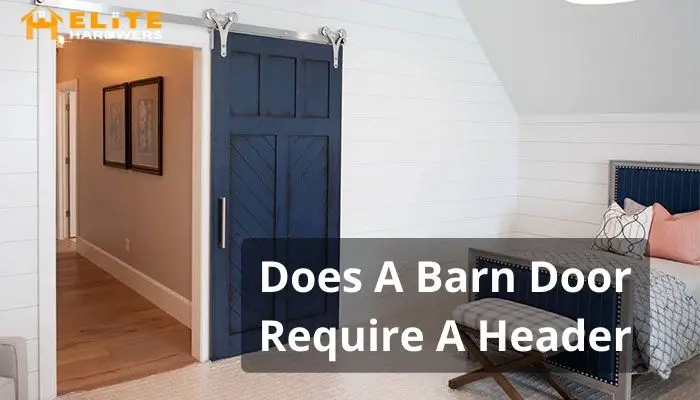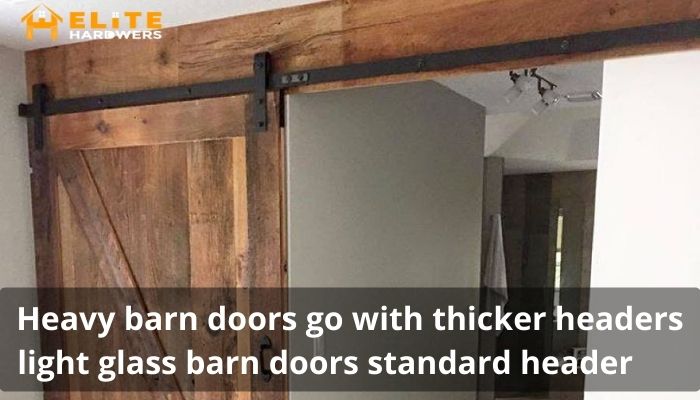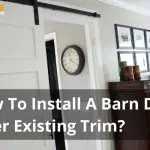Does A Barn Door Require A Header?
Barn doors operate through sliding on a set of door hardware kits. The hardware kit needs an anchorage point, hence a header. Using the header will make it easier to fix the barn door.

The barn door requires a header to attach the door hardware kit and carry the weight of the door. At times, the hardware kit can be anchored on the studs eliminating the use of a header.
In this article, we shall discuss in detail whether or not the barn door needs a header. We shall also expound on how to install the barn door without a header.
Does A Barn Door Require A Header?
If this is your first time installing barn doors, you might be wondering, do you need a header board for barn doors? The answer is dependent on your preferences. You can have your barn door with or without a header.

What is a header board on a barn door? The header board gives support and point of anchorage for the door hardware kit. Having a header in place will make your barn door installation easier. Therefore, the barn door requires a header.
However, you can improvise it by attaching the door hardware kit to the studs. Using the studs will require modification of the process to cater for the missing header.
How Thick Should A Header Board Be For A Barn Door?
Headers are designed in different ways to carry different door weights. Heavy barn doors will call for thicker headers, while light glass barn doors will do with a standard header.

When you think of the size of the header, you must consider how thick should a header board be for a barn door? Despite the varying factors, the header has a standard thickness of 1” minimum. The header can be thicker than 1” if your door is heavy or the material used is weak.
Purchase the smart standard barn door hardware kit for a better installation process. Ensure the header is attached to a strong support system such as the house pillars and frames.
If you are unsure of the header size, ask a technician what size header board for barn door you require. Avoid drilling excess holes on the header as it will weaken it.
What Do You Use For Barn Door Headers?
You might be trying to figure out what do you use for barn door headers? Barn door headers need to be strong enough to carry the weight of that door and the hardware kit. Some doors weigh as heavy as 200lb and hence need a strong support system.
The most common barn door headers are made of wood. We recommend installing alder wood planks, cedar, oak, or mahogany headers. For the heavy barn doors, consider using the steel headers.
You can also use a backer board for a barn door, preferably a 1 by ¼ inch board. Ensure the backer board is longer and wider than the track.
How To Install A Barn Door Without A Header?
You can comfortably fix a barn door without header. The door header is usually used to provide extra support to the drywall for carrying the weight of your barn door. The header also provides space for installing the track on which the barn door will slide.

However, the header can be ignored, and instead, install a barn door over existing trim without a header. Follow these simple steps to install your barn door.
You are going to need the following tools;
- Screws
- Drill and drill bits
- Level
- Hanger and bottom rollers
- Steel track
- Barn door spacers
With a ready-made barn door, all we need is to attach the track to the studs and hang the barn door with the hangers.
Step 1 – Locate the position of the studs
To attach the track, we need strong support, which is the studs high in the ceiling. You may have to cut open the wall to locate the studs. Add support systems to the ceiling studs in correspondence to the holes on the track.
Step 2 – Install the track
Since we don’t have the header, you can hang the track using metallic hangers attached to the roofing. This applies when there is no strong support system behind the wall.
If you locate strong studs, fix the track on the wall. Start by drilling holes through the wall to the studs using the drill bit machine. Ensure the holes on the studs fit in with the holes on the door track. Use the screws for barn door header to hold the track in place.
The track should be at least twice the width of your barn door. Secure the track with screws and bolts using the screwdriver. Be keen to check on the level balance of the track using the level.
Ensure you leave enough space between the ceiling and the track for roller clearance, reducing barn door problems. The track’s position should be well calculated to ensure the door is fixed without leaving gaps at the bottom.
Install stoppers and control guides at both ends of the track to keep the door in place.
Step 3 – Fix the sliding hardware
Once the track is fitted and level checked, you can install the hanger rollers on the top edge of barn doors. Have at least two hangers for the balancing effect. Give an allowance of ¼” from the edge of the barn-door and secure the door with screws.
To have your barn door close automatically, fix the soft close hardware. If you don’t know how to fix a soft close barn door, check for tutorials on their official website. Fix the soft close barn door hinge behind the rails. The damper slowly brings the doors to a soft close.
Step 4 – Hang the barn door
Hang the door with the barn door’s hardware kit. Ensure the rollers fit well onto the track. Request for assistance if the barn door is heavy for you. Fix the spacer to keep the door in position and avoid damaging the wall.
Should a barn door cover the trim? Yes, the barn door should cover the trim to prevent light rays and noise from penetrating through the gaps. Once the barn door is properly fitted, have the stoppers engaged to keep the door in place.
Add shims at the bottom of your barn door to ensure no big gap is left between the door and the floor. For an attractive finish, paint the hardware to make it look like a barn door with header board.
Final Words
For a strong and long-lasting barn door structure, we recommend using a thick header of about 1-inch thick. The header should be longer and wider than the track for better support.
However, you can get your barn door fixed without the door header, locate the studs on the ceiling and use them to attach the barn door hardware full kit. To avoid injuries while installing the barn door, exercise the protective measures such as wearing your helmet.
This article has discussed several factors concerning the barn door installation with and without headers. With this article, you don’t have to be worried whether a barn door requires a header or not.





